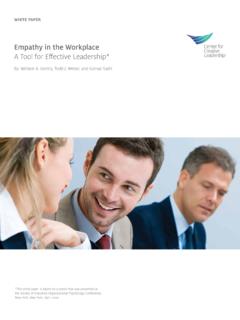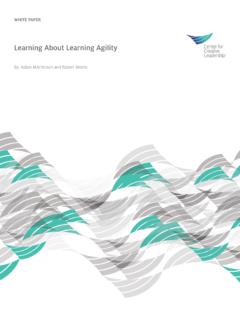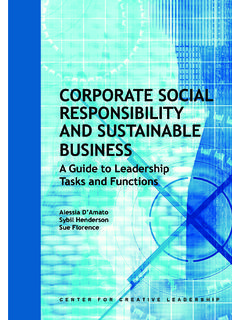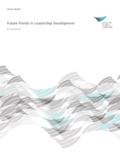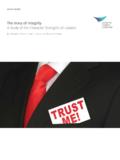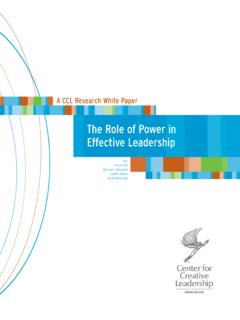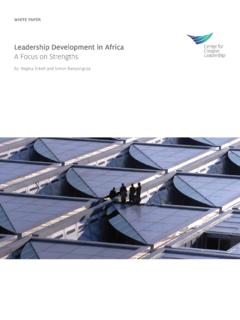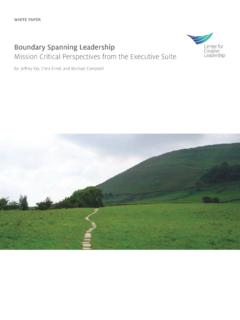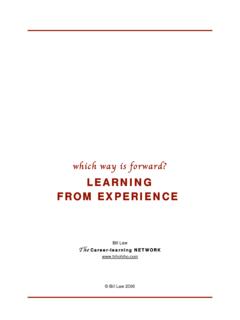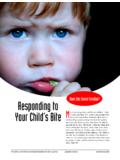Transcription of Blended Learning for Leadership The CCL Approach
1 WHITE PAPERB lended Learning for LeadershipThe CCL ApproachBy: Ron RabinContentsExecutive Summary 1 The Learning Challenge 2 Redefining the Blend 3 The Learning Challenge 4 Additional Resources 8 About the Author 9 2014 Center for Creative Leadership . All rights reserved. 1 Executive SummaryBlended Learning is often defined as a mix of classroom and virtual training events. But Blended Learning for Leadership must go beyond coursework to engage leaders in the domains of developmental relationships and challenging assignments, which research shows is critical for leader development. Redefining the blend to bring Learning clos-er to the workplace and provide appropri-ate scaffolding for the learner s needs is still a struggle for most organizations. Though no one has this completely figured out yet, the Center for Creative Leadership (CCL ) is starting to see results in several key 2014 Center for Creative Leadership .
2 All rights Learning ChallengeCCL believes that Leadership is learned. Today, more than ever before, a manager s ability and willingness to learn from experience is the foun-dation for successfully leading with impact. How do you become a leader? Consider the 70-20-10 rule that emerged from 30 years of CCL s Lessons of Experience research, which explores how executives learn, grow, and change over the course of their careers. This rule suggests that successful leaders learn within three clus-ters of experience: challenging assignments (70%), developmental relationships (20%), and coursework and training (10%). Most organiza-tions acknowledge that formal training alone can be limited in impact. Yet they continue to invest most of their training budget in classroom events and eLearning assets.
3 They struggle with how to systemize and evaluate a Learning strat-egy that also includes workplace experiences and organizations embrace Blended Learning , which is typically defined as a combination of traditional classroom training with some form of virtual Learning , such as eLearning modules, we-binars, or virtual classroom events. The amount of classroom-based, instructor-led training in companies has recently dropped below 50%, accompanied by a rise in virtual classroom events and online self-study (O Leonard, 2013). And it s true that by combining the strengths of the classroom experience with the on-demand features of virtual Learning , this form of Blended Learning can enhance workplace-based Learning . However, many of these Blended Learning programs classroom or virtual still fall into the 10% coursework and training cluster: a sequence of activities designed by a trainer to achieve specific Learning objectives.
4 While the on-demand or flexible elements are certainly more convenient to the learner and often less expensive for the training department tradi-tional Blended Learning solutions often leave the critical 90% of Leadership development experiences 70-20-10 Rule for Leadership DevelopmentCHALLENGE ASSIGNMENTSDEVELOPMENTAL RELATIONSHIPSCOURSEWORK AND TRAINING70%20%10%70-20-10 2014 Center for Creative Leadership . All rights reserved. 3 Redefining the BlendTrue Blended Learning isn t merely mixing classroom and virtual training events. Instead, it s a combination of formal Learning combined with workplace-based or informal Learning opportunities addressing all seg-ments of the 70-20-10 rule. This is not to minimize the impact of classroom-based training far from it. The classroom offers unique opportunities for skills building, peer Learning , assess-ment, experiential activities, coaching, and critical reflection time, all in a safe and confidential environ-ment removed from the distractions of the workplace.
5 Over the years CCL program participants have described these classroom events as life-changing experiences. Online elements like short video lectures, single-player simulations, and virtual classroom events can offload lecture content and better prepare participants for a face-to-face classroom experience focused on interac-tion, skills building, and rich feedback. Post-classroom tools like job aids, apply the Learning packages, one-on-one coaching, and check-ins via social media can extend the Learning beyond the classroom. But informal Learning adds spontaneous, unstructured, learner-driven experiences to the mix. It leverages as-sessment, challenge, and support (CCL s ACS Model ) for the unique workplace challenges and opportunities of each leader. Transfer of training becomes less critical as Learning is actually embedded in the work environ-ment.
6 Context forms a critical part of Learning is often haphazard and triggered by external events (job assignments, market conditions, mergers, etc.). But you can support and enhance infor-mal Learning significantly. Leaders can engage in more critical reflection to surface tacit knowledge. They can become more proactive in understanding how they learn best and identifying additional opportunities for informal Learning . You can add outside perspectives to avoid the blind spots most of us encounter in our as-sumptions about ourselves and our career plans, as well as to better interpret mistakes and social and cultural norms (Marsick & Watkins, 2001).Personally, I m always ready to learn, although I don t always like being taught. Winston ChurchillTrue Blended Learning is a combination of formal Learning combined with workplace-based or informal Learning opportunities addressing all segments of the 70-20-10 2014 Center for Creative Leadership .
7 All rights scaffolding must enter into the leader s own workplace Learning ChallengeThe challenge is to support the learner with appropriate materials, technology platforms, and other scaffolding in the critical Leadership domains of assignments and relationships. Leadership does not happen in isolation. In addition to traditional Leadership competencies like communication and influence, CCL research suggests that great leaders demonstrate skills like:These topics and others can be discovered in the classroom or through virtual Learning . But learner scaffolding must enter into the leader s own workplace environment for these types of skills to be practiced and improved. All components need to address behavior change in the perspective: looking beyond the organization chart to the invisible, informal connections in the organizationPolitical savvy: leveraging new and existing relationships to achieve organizational, team, and individual goalsBoundary spanning: operating at the white spaces or gaps across teams, functions, organizations, or geographies to help diverse groups achieve a larger shared vision 2014 Center for Creative Leadership .
8 All rights reserved. 5 2013 Center for Creative Leadership . All rights Assignments increases in scope horizontal moves new initiatives turnarounds mistakes and ethical dilemmasCoursework and Training classroom-based skills building virtual classroom events and check-ins games and simulations eModules books, articles, and white papers90% of LearningINFORMAL The Best of Both WorldsBlending formal and informal Learning experiences for better resultsOn-demand LearningeModules, Webinars, Video Vignettes, Job Aids, AssessmentsSocial LearningYammer, Twitter, Blogging,Games and SimulationsCCL in the WorkplaceAction Learning , Reflections, Post-program Coaching, Learning Cohort Check-ins20%Developmental Relationships70%Challenging Assignments10%Coursework and TrainingDevelopmental Relationships communities of practice networking executive coaching workplace coaching and mentoring bosses and superiors10% of LearningFORMAL 6 2014 Center for Creative Leadership .
9 All rights way leaders learn will change dramatically in the next few years. No one has this figured out completely but we re starting to see results based on our understanding and research of leaders and how they learn. Specific areas that CCL is exploring include:Feedback Honest feedback is critical to perfor-mance improvement yet difficult to ob-tain and give. Tools and job aids for deliv-ering (and receiving) effective feedback can be brought back from the classroom to the workplace team. Online tools offer convenience, template-based assistance, even anonymity when desired, and can help make continuous feedback a and Mobile Learning Apps are now embedded in the flow of our lives and are arguably the num-ber one Learning tool used outside the workplace. Apps for Leadership include performance support tools and job aids, Learning nuggets, and quick remind-ers and effective examples that can be summoned up in a moment, not remain buried in a Learning management Media Social media in the workplace means dif-ferent things to different people: exper-tise location, community building, online teaming, virtual water cooler, my online brand, relationship building.
10 Pick your favorite in the end it s about connect-edness. And aside from self-awareness it s difficult to think of a Leadership skill that doesn t tie directly or indirectly to connectedness. In an increasingly virtual world you can t neglect this channel for The current excitement in higher educa-tion is the massive courses (thousands or tens of thousands of students enrolled in a single virtual class) available for free from organizations like Coursera or EdX. The size and global scope of a Massively Open Online Course (MOOC) offers the opportunity to explore and question cultural ideals of Leadership , to engage in peer Learning on a massive scale, and to experiment with behavior change in the workplace and provide feedback and adjustment while the course is still underway.

